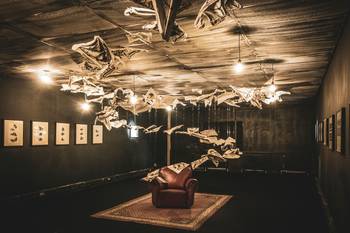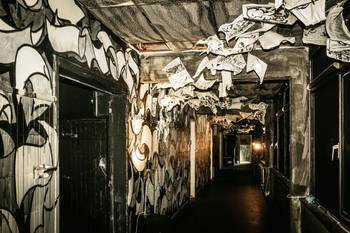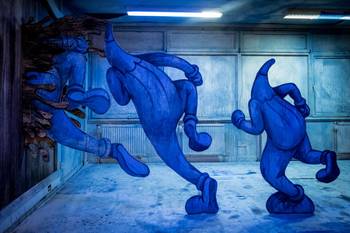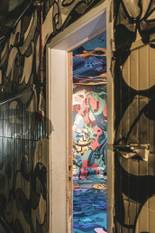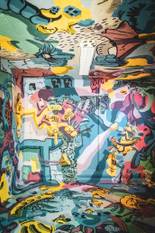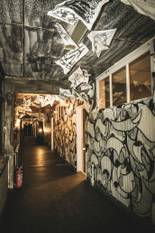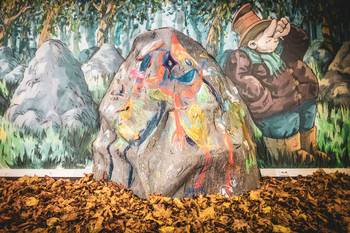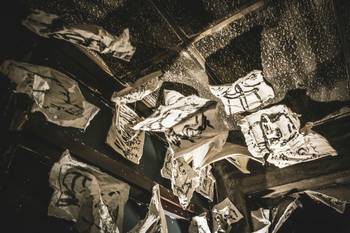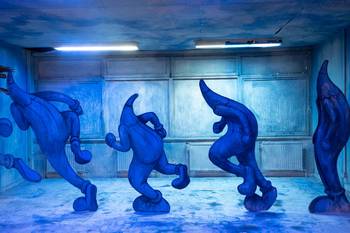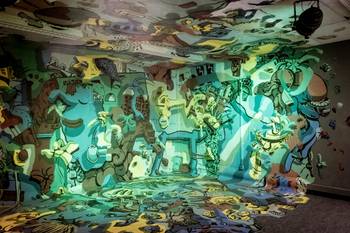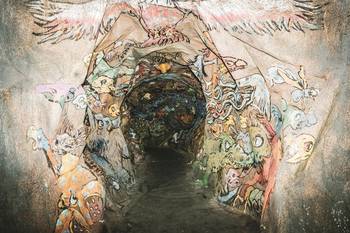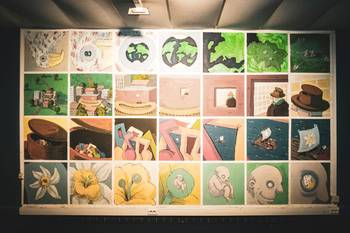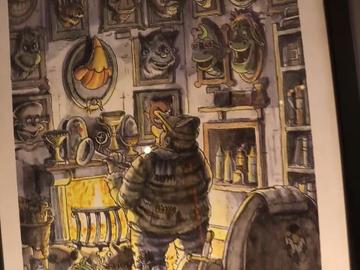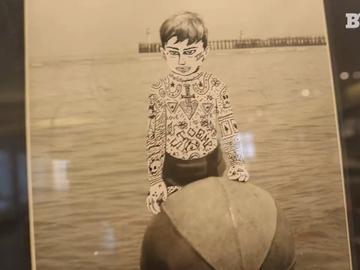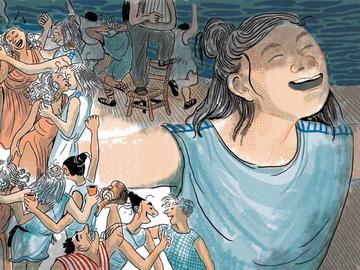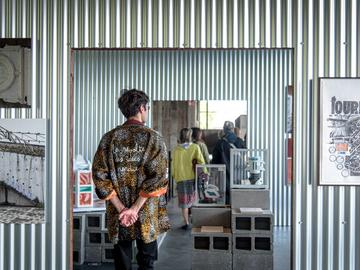One day in a faraway future, a painter will appear as if from nowhere. People will marvel at his work and wonder why they haven't noticed him before. And Créons, with a giant smile and a nostalgic fog in his eyes, will reminisce about those precious moments spent out on the streets, spraying his crayons all over the city, when he was still one of Brussels’ urban myths.
© Heleen Rodiers
For more than ten years, Brussels has been a canvas for the primal thoughts, complex emotions and intimate reveries of an anonymous, wandering soul. A soul that moves through the dead of night and beyond the fringes of the law, to fill silent spaces and moving train cars, open endings and middle of nowheres, the cracks, tears and wounds in the urban landscape with curiously colourful characters. Crayons in all shapes and sizes – dancing, playing, hiding, greeting, thinking, popping up, sneaking out, undressing, painting, speechlessly commenting or just hanging out. Crayons in love, out of time, on the phone, on vacation, under pressure, overwhelmed, down and out, among friends…
I have ignored them in my worst moments, devoured by the rush of the day or the occasional low in life. In all other moments, they have stunned me, comforted me, tickled my curiosity, put a smile on my face, filled me with a sense of wonder and made my day. How odd, I would think from time to time, that this batch of swiftly and seemingly effortlessly painted crayons, without even the most basic facial features, would become points of reference to me, friendly faces in the sometimes violent turmoil of the city. I did not even know who to thank for that. The crayons’ creator remains anonymous, hiding behind the moniker “Créons”, a French play on words referencing both his coloured pencil characters and the call for gentle action: “Let’s create!” Rumours were even that “he” was many – “just look at the sheer number of paintings (several thousands) and their variety in styles.”
GRACE AND CHAOS
Then, late last year, a book was published: L'autre part, the first graphic novel by Créons and a way to dive deeper into the myth, that had already spilled over from the streets into exhibitions in a dilapidated home in Schaarbeek/Schaerbeek in 2014 (“Mine de rien”) and the former hardware shop Le Siffleur in the Marolles district in 2016 (“Quelque part”). Two magical, utterly exciting shows, that showed the potential of “just creating”, without taking formats, frames, preconceived ideas, expectations or limitations into account. A generous, fun and intimate exploration of possibilities, resulting in paint-covered floors, walls and ceilings, three-dimensional objects bursting with life, enigmatic installations, poetic words borrowed from admired artists, playfully adapted paintings found at flea markets and so much more.
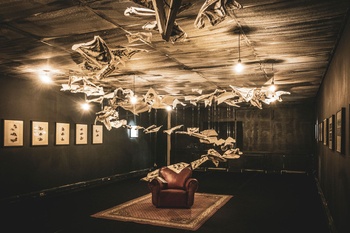
© Heleen Rodiers
| Créons: “Once the work has been made, I disappear.”
L'autre part – a book in the form of a journey between dream and reality, an addictive exploration of the multifaceted self, its origins and its future – was meant to evolve into an exhibition of the same energy, but the second Covid-19 wave put a spanner in the works. Until today. At the See U complex, the temporary occupation of the former Fritz Toussaint barracks in Elsene/Ixelles, the first floor of the E building seems to fold in on itself, like an excavation of the heart chambers of the book. I wander from early first sketches, ideas, rebuttals and scenarios to finished original drawings from the book, from imposing sculptural installations and a gorgeous scale model of Brussels’ rooftops to a pitch-black cave, where the light of my mobile phone reveals a breath-taking flurry of colourful madness.
In the hall, a paper trail connects every room, every moment of wonder to the next and at the end of the trail awaits Créons. Hidden behind a scarf, but in the flesh. One, not many. “Wasn't it too much?” he asks doubtfully. “Wasn't there too much to see? I know that I don't really tend to be very selective. If I make twenty failed attempts and end up with one successful drawing, it's often those twenty misses that I find the most interesting. The road you travel, the work you put in. And also, I simply don't know how else to do it. This is not a gallery exhibition, so I don't have to limit myself to three sparsely selected canvases. (Laughs) If it gets too clean, too slick, I always feel like breaking that. For me, it is important that the DIY atmosphere is tangible, that everyone is welcome here, that even a teenager can smash his piggy bank and go home with an original work. Fortunately, this building allows me to pull out all the stops.”
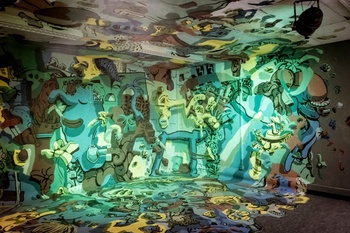
© Heleen Rodiers
| In “L’autre part”, the book and the exhibition, Créons moves between dream and reality.
“I have seen fantastic things in galleries and museums, but I have always found it a great paradox to exhibit there myself. Reducing the endless space you have outside to a few small formats. Then there is the position of the artist, in the centre of attention. I value my anonymity. Once the work has been made, I disappear.” It is that sincere doubt – “navigating between a state of grace and complete chaos”, as Créons calls it – which filled me with admiration in 2014 after seeing “Mine de rien”. That exhibition allowed visitors a glimpse inside the anonymous artist's internal battle. One painting in particular – of one of his crayons scratching his pencil tip amidst an excess of philosophical signposting – is still etched in my memory. What road to take when your options are to err, to doubt, to dig, to act, to run away or to become?
IN COLD BLOOD
It is this doubt that gives life, this groping that gives depth and supports warm humanity. “Totally!” Créons replies. “All the time up to this moment, this bubble, the days and weeks and months that I spent on my own or with friends, trying, failing, arguing, someone making a comment, getting stuck, regaining confidence, finding the will to go all the way... That is what I look back on with such joy, what I am nostalgic about already. The same applies to my work in the street. Graffiti is often looked at and judged as a result. But what really matters is what precedes that mural. How you manage your nerves, prepare your material, how you meet up with friends, get to know the city, burn through the night... Even if you don't push your art to the limit − which happens sometimes − you still have experienced that adventure, that moment among friends, travelling together into the unknown. Those moments fill life, create stories. Those side stories are perhaps the most beautiful side of graffiti.”
In graffiti, even if you don’t push your art to the limit, you still have experienced that adventure, that moment among friends, travelling together into the unknown. Those moments fill life, create stories. Those side stories are perhaps the most beautiful side of graffiti
“And it is pretty much the only art form that links painting to adventure,” says Créons. That adventure beckoned when he was twelve years old and felt the strange pull of that medium that he did not understand and that made him want to understand it. “I started with classical graffiti, writing letters. It didn't take long before I realised that I wasn't made to live by those codes. I couldn't find myself in them, it was complex. Then I really started looking for an image, a symbol, that I could feel at home with. I made a list of different possibilities and the crayon was the first image on that list. From the first attempt to realise that image – in the Kroonlaan/Avenue de la Couronne, not so far from here, funnily enough –, I felt an enormous freedom. No matter how awkward the execution was, no matter how much I didn't have a clue about anything yet. The possibilities for varying that one image were endless.”
This is evident from the thousands of crayons that have populated the city up to now. “People sometimes ask me if I don't get tired of my crayons. Not that I compare myself to Hergé, but did they ever ask him if he still liked making Tintin? There is so much more than just the character. For me, that one image is a fantastic pretext to explore other paths. In L'autre part, by the way, he is much less present than the landscapes he crosses. Because that also represents my current fascination. He is a metaphor of myself, in a way. He is born of a desire that metamorphoses little by little. I don't feel like denying myself anything. That's the worst thing you can do in painting: get stuck in mechanisms, see that something works and only do that. Then you don't risk anything, you don't surprise yourself, you don't put yourself in danger. That feeling fuels what I do.”
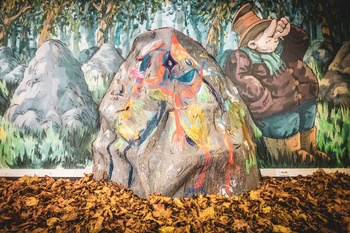
© Heleen Rodiers
“By the way, with every crayon I add, the danger grows if a problem ever arises. What I do in the streets is illegal, I have known that from the beginning. The awareness that you are breaking the rules, that you are doing something that they have always advised you not to do, that you have to watch out for passers-by when you try to get that thing on the wall at three o’clock in the morning...that is a problem I’ve always had. The first hundred times, my hand trembled incessantly. Just because I was always told that if you break the rules, you are a bad person. It took me a while to develop a certain cold-bloodedness, a certain calmness in that − a calmness that has helped me in so many different aspects of life in the city. To make myself understand that it's okay, that it’s no big deal, that I’m not out to kill or hurt anyone. That all the walls are still there, and that if the owner of those walls likes them white, he will paint them white again.”
BÊTE NOIRE
“Do I make the city pretty? Maybe not. But I don’t feel like I am degrading it either,” Créons continues. “After I had visited a friend in the south of France in 2016 and had derived so much pleasure from painting landscapes there, outside on an easel, I tried the same thing here. Just during the day, in broad daylight. I took a stool, sat down in front of an electricity cabinet and started to paint. The people loved it. It’s funny how, when you leave the spray can behind and start painting with a brush, everything changes. While I still did not have permission, while it was exactly the same gesture and just as illegal.”
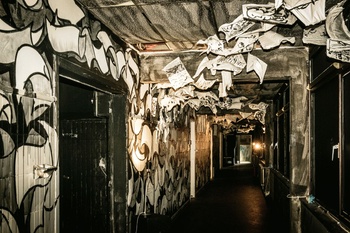
© Heleen Rodiers
“Le monde sommeille par manque d’imprudence.” That quote by Jacques Brel, from the song “Jojo”, already graced the exhibition “Mine de rien” in 2014 and remains relevant today. “Imprudence means taking risks, allowing uncertainty and doubt, not knowing where you are going. It's hearing Manu Larcenet talk about Blast, how he threw all the rules overboard for that four-volume comic book and started working on scraps of paper, and finding in it a way for myself to finally make that book, at the same time a childhood dream and my bête noire.”
Créons is all about innovation, experimentation. The limitless possibilities of techniques and tools. “People see graffiti as something very repetitive, they don’t realise how complex it is searching for the limits within the constraint of always having the same character. On the other hand, that returning character is also reassuring. Subconsciously, that must have played a part when I painted my first crayons. When I arrived in Brussels at eighteen, the city was a jungle to me. Everything was buzzing around me, full of life... My crayons were a way of populating the roads I walked, the places I visited, with friendly faces. Points on the map that allow you to find your way. Graffiti for me has never been a way to conquer the city, but to make it my own.”
To me, graffiti has never been about conquering the city. It was a way to make it my own, to populate the roads I walked, the places I visited, with friendly faces. Points on the map that allow you to find your way
As opportunities to live. “And to soften that life, yes. Many people still harbour this impression of graffiti as something very aggressive. I have never experienced it that way. Of course you have the occasional bad boy, that game of impressing and outwitting. But I am not the aggressive type. On the contrary. I am sometimes asked if I am aware of the fact that my crayons are so charming and cute. That is also not my intention (laughs), but aggression is certainly even less part of my nature. People just end up fixated on the medium, on that wall.”
The reasons are clear, but still...in that work that sometimes brutally and unexpectedly finds its way into other people's walls, there is much to cherish. L'autre part, the book, crystallises those aspects. It tells about childhood and naivety, about graffiti and art, about that piece of wood that transforms into a pencil, about the struggle of the artist and the person, the search for the self through an adaptation of the myth of Narcissus, the choice to exist in the shadows, the ego-tripping and the friendship, “tender and fun, but also utilitarian when it suits. I wanted to explore the whole spectrum, to give vice a place too. To stretch a continuum that reaches from the self to the other. What does finding yourself mean? To be yourself? What does that self consist of and how can you track it down? Do you need the other person's glasses for that? It was interesting to dive into those questions, to be shot back and forth like in a philosophical pinball machine and to think about my own answers.”
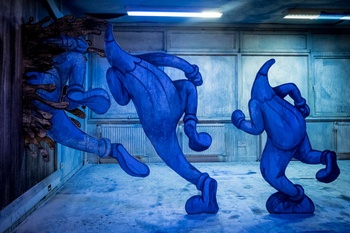
© Heleen Rodiers
| Créons: “From the first attempt to realise my crayons, I felt an enormous freedom.”
“Do I need the city? Do I need my crayons? I do not know. Just as I still don't know the exact story I wrote with them. The urge to be seen on the walls of the city comes and goes. Maybe one day I will manage to leave the city behind. The calm that I need so much, and that presents itself as a kind of stillness in the dead of night, I also find in nature. The sunlight piercing through the trees, the complexity of it, the harmony of nature, fascinate me so much more than the angular and plain and orderly of the city. Indeed, a building does not grow. A building is ordered, delineated. Averse to the accidental.”
“So none of that is vital to me. What matters is the dialogue, others who allow you to find yourself. For me, painting is such an other. Therein lies the power and the endless amazement, the magic that comes about arbitrarily and unconsciously. It is painting, yes. In any place, on any medium.”
CRÉONS: L’AUTRE PART
Book: CFC Éditions, 224 p., €24, www.maisoncfc.be
Exhibition: > 27/6, See U, www.les-crayons.com
Créons: L’autre part
Read more about: Expo , Créons , L'autre part , CFC Editions , See U
